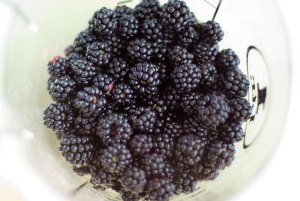
Do you also have an obsession of going to supermarkets in foreign countries? Personally, I think it’s exiting to see what’s similar, what’s different and to find things I’ve never seen before.
When I was on vacation in France in September, I found fresh “Piments d’Espelette”, or Espelette pepper. Espelette is a small town in Basque Country, near the Spanish border and famous for the houses covered with festoons of drying peppers. When the peppers are fresh, they are bright red and look like regular Hungarian peppers, but are definitively hotter. When they dry, they get darker until they look almost black. They are not extremely hot, but definitely too hot to be eaten as such.

Somehow in my mind, the visual similarity to the Hungarian bell peppers made me think of Gulasch, the perfect dish for cold autumn evenings. And it’s true what they say, Gulasch tastes much better on the next day!
GULASCH / GOULASH
750 g / 1,5 pounds beef
500 g / 1 pound onions
1 small garlic bulb, peeled
4 piments d’Espelette or bell peppers
3 tablespoons olive oil
2-3 tablespoons paprika powder
6-8 tablespoons tomato paste
750 ml / 3 cups / 1 bottle red wine
250 ml / 1 cup water
1-2 teaspoons salt

You won’t need much knife skills here, everything is cut into chunks. Cut the meat into dice – I like them in the 2.5 cm / 1 in range.
Peel the garlic and leave the cloves as they are. Maybe you could half one or two if you have very big ones.
Also, peel the onions, then dice them very coarsely. I only had rather small onions, so I halved them and cut the halves into quarters.

Now it’s the time to get out your latex gloves – especially if you are wearing contact lenses. Imagine rubbing all the capsaicin into your eyes while trying to get out the lens. No fun! By the way, capsaicin in hydrophobic, so use something fatty to make the burn less painful – like heavy or sour cream, cheese or olive oil.
Depending how hot the peppers are, remove the seeds completely or just some of them, then cut the flesh into nice little strips.

Get out your favorite large and heavy pot – mine is a blue Dutch oven I bought in France. They are called “cocotte” around there and “mini-cocottes” absolutely in this year. You see them anywhere, even at gas stations.
Heat the put up while it’s empty on medium-high heat, test if a drop of water “dances” around, then put in the oil. Let the oil get hot too, you’ll see ripples and just a tiny wisp of smoke, then put in a third of the beef cubes at max. Leave them alone and don’t try to turn them until you find that the sizzling noises sound a bit differently. Then try to turn the meat gently, if it still sticks, leave it alone for another minute or so. Maybe it just needs to get a little bit browner, then it won’t stick to the bottom any more.
When the meat has a nice brown color, put in the next few meat chunks and go on as above. Then repeat with the rest of the meat.
I like to brown the meat in 3 to 4 installments, because putting all the meat in the pot at once makes the temperature of pot and oil drop very quickly – and that results in the meat cooking and losing too much juice, and not frying.

If you have a pot that is big enough, you can simply add the onions and the garlic and let them brown with the meat. But in this case, my meat bits were getting in the way, so I put them out and then the onions in. Let it all get a nice touch of color.
See how the onions release a little bit of water and dissolve the brown bits from the bottom of the pan? This is why I always fry the meat first, and then the onions. I’ve tried it the other way round and ended up with onion coals and the meat not browned at all.

OK, get the meat back into the pot and and add the peppers, too. Then the paprika powder and the tomato paste and let it all get a tiny little bit of color.

Open the bottle of red and put it all in. No, this is no waste. You don’t have to by a Grand Cru for that, just something dry and red and heavy, like a Chianti, Shiraz or Rioja.
And don’t forget the salt…

Now, all you need is time. Cover and let it simmer (on low) for several hours, until the meat is soft. In fact, it should be so soft that you can separate the meat with a fork. Add a little bit of water if the meat is not covered any more.

See, no knife needed! And the onions and garlic are all cooked down to a thick and aromatic sauce.
Serve the Gulasch with potatoes, pasta or whatever else you like. And of course you remembered to buy a second bottle of that red? Then pour yourself a nice glass to go with it.
























































